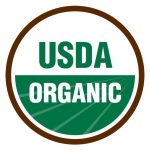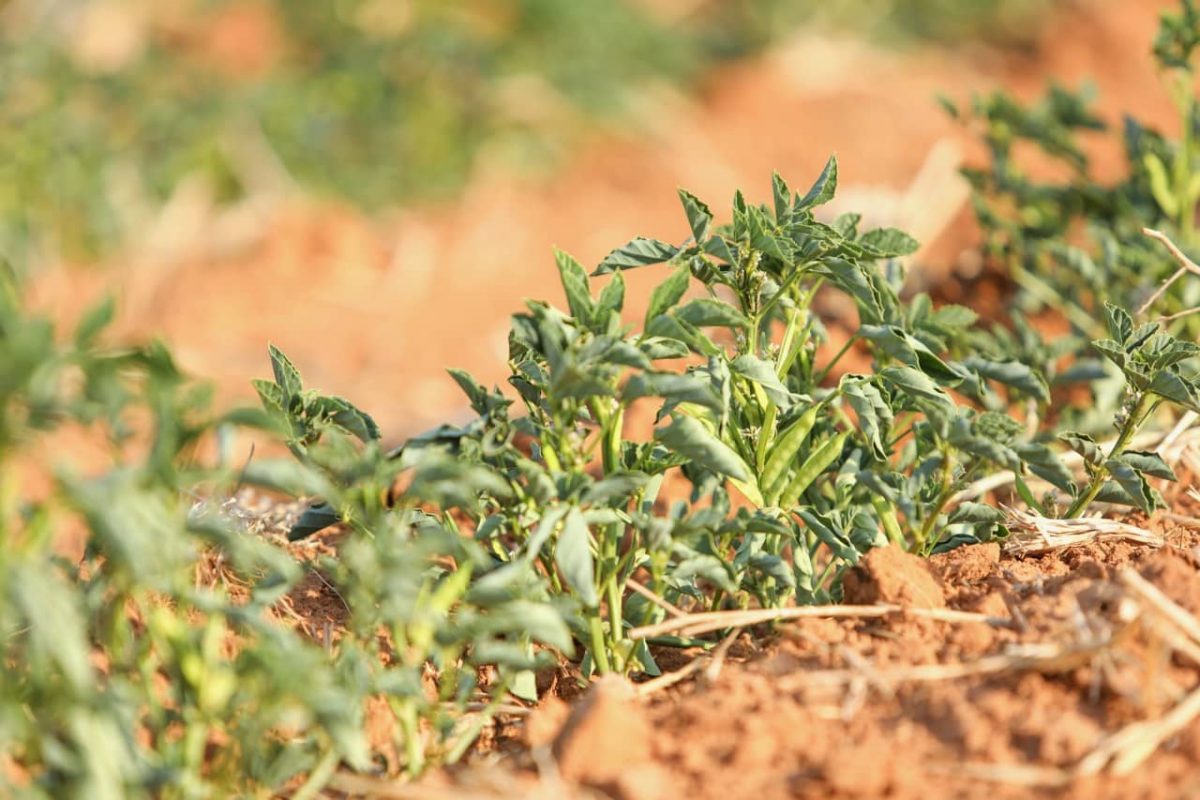
Guar gum powder has earned a noble spot as a pantry staple in the kitchen cabinets of every homeowner and commercial chef right next to salt, pepper, butter, flour and olive oil, even if as of this writing there are still many who may not be familiar with this superior food additive.
Guar is indispensable in baked goods, as it has the unique ability to improve texture and crumb structure while at the same time contributing to both dough yield and the extension of shelf life. It serves as an excellent binding agent for ingredients found in gluten-free recipes and is known to thicken batter.
It stabilizes the preparation of processed cheese; improves the melting capabilities of ice cream; thickens soups and gravies; improves texture and moisture retention in pasta and the flow properties in sauces and dressings.

Where Does Guar Come From And How Is It Grown?
Guar gum is a desert legume that has been grown in the United States since 1903.
In 1945, due to the war shortage of locust bean gum (LBG), guar gum was studied as a potential substitute. Since the 1950s, guar gum has been used to make processed foods, in which it acts as a thickener and prevents the formation of ice crystals, which is essential to the creamy aspects of ice cream.
Today, the leading producer of guar gum within the United States is Guar Resources.

This short-duration crop is harvested within 3–4 months of its planting. It requires rain before planting and again afterwards to induce maturation of the seeds. Guar contains large amounts of guar gum, which transforms into a gel when the bean is ground into a powder and then mixed with water. It is this powdered form that is used both as an ingredient in foods and as a supplement.
The majority of Guar is grown for its endosperm (guar gum), and the seed is approximately 45% protein, with the endosperm being 29% and 26% hull. Guar seed endosperm is a source of water soluble gum, which is utilized as a stabilizer, emulsifier and thickener in a multitude of food products.
The gum is commercially extracted from the seeds of the plant via a process that has four main steps: roasting, de-husking, grinding and sieving. The remaining purified, powdery substance is an off-white, flour-like powder with an earthy odor known as guar gum.
Some of the many foods containing guar gum powder include: ice cream, yogurt, reduced sugar drinks, gravies, sauces, gluten-free baked goods, cheese, soup, pudding and breakfast cereals and smoothies and health shakes to just name a few.

In addition to food products, guar gum is also found in industrial applications, cosmetics, medications, textiles, and paper items. In manufacturing, guar gum serves as a binding agent in tablets, a substitute for paper pulp, as a thickener in lotions and creams and many other applications as well.
Why Should Guar Powder Be In Every Kitchen Cabinet?
Below are six reasons why every home cook and every commercial chef should always have a container of gum gum powder within reach inside their kitchen cabinets.
1. Guar is The Most Effective Thickening Agent
It is estimated that guar gum has almost 8 times the thickening power of cornstarch, which has twice the thickening strength of flour. In terms of recipe applications, for every 2 Tablespoons of flour per cup of liquid, about 3/8 teaspoon of guar gum would be required.
When heated, guar gum does not break down, which is not the case with corn starch. However, this capacity to thicken without heating does require a few minutes to hydrate. For this reason, experts recommend heat when processing guar gum.
2. Guar Is A Natural Product
Guar gum is superior to other gums because, unlike Xanthan gum, for example, it is made naturally from guar beans. Grown in the United States via sustainable farming, guar is also gluten-free, vegan, kosher and halal certified. When artificial sources are utilized in production, chemicals can affect the taste of the finished product, and this is never the case with guar gum powder.
3. Studies That Suggest Guar Has Certain Health Benefits
Guar Gum May Lower Cholesterol
Soluble fibers, such as guar gum, have been shown to have cholesterol-lowering effects. During the 1980s and 1990s, Finnish scientists at the University of Kuopio, studied the effects of guar gum powder on people with diabetes and high cholesterol.
Their studies included both Diabetes 1 and Diabetes 2 sufferers and concluded that guar gum lowered blood glucose after meals and improved long-term blood glucose control.
According to lead researcher Helena Vuorinen-Markkola, while guar gum cannot replace diabetes medications, it can possibly be harnessed as a complementary treatment. A 1983 animal study conducted by J M Gee, N A Blackburn, I T Johnson involving rats revealed similar results. Rats that were fed guar gum developed reduced blood cholesterol levels, and increased levels of HDL (good) cholesterol.
Guar Gum May Promote Weight Loss
There is some interest in using guar gum for weight loss because it expands in the intestine, causing a sense of fullness. This may decrease appetite and ultimately, caloric intake. One review of three studies concluded that guar gum improved satiety and reduced the number of calories consumed from snacking throughout the day.

Another study conducted in 2011 by J Tuomilehto, E Voutilainen, J Huttunen, S Vinni, and K Homan studied the effects of guar gum on weight loss in women. They found that consuming 15 grams of guar gum per day helped women lose 5.5 pounds more than those who took a placebo.
Note: While these studies show guar may promote weight loss, our experts at Guar Resources do not claim Guar Powder to be a weight loss supplement.
Guar Gum Can Promote Digestive Health
The high amount of fiber found in guar is thought to promote a healthy digestive system. One 2014 study indicated that the ingestion of guar gum aided in the relief of constipation by speeding the movement of partially hydrolyzed guar gum through the intestinal tract.
The consumption was also associated with improvements in stool texture and bowel movement frequency. Another 6-week study conducted in 2006 and led by Edoardo G Giannini, followed 68 people with Irritable Bowel Syndrome (IBS) discovers that partially hydrolyzed guar gum improved their symptoms. Plus, in some individuals, it reduced also reduced bloating.
Note: PHGG, which was used in this study, is a guar derivative and is chemically treated, so it cannot be called “natural”. Guar Resources does not produce PHGG.
4. Guar Gum Is Gluten-Free
Guar gum is a thickening ingredient often used in gluten-free cooking because because it helps to provide the structure that is lost when gluten is eliminated from a recipe. It mimics the properties of gluten and serves as binding agent and volume enhancer in many baked goods.
Guar gum helps to thicken batter and prevents the ingredients from separating. It also serves to trap air within the mix, which ultimately makes the batter rise. Using it increases moisture retention and extends shelf life.

Talk with a doctor first before using guar as a supplement, as guar can decrease the effects of some medications. The typical dose used in research studies, such as those conducted at the University of Helsinki, is: 1 teaspoon (5 grams) mixed into water, juice or milk 3 times a day. For use in baking: add 2 teaspoons (10 milligrams) for every cup (225 milligrams) of flour in a recipe.
5. Guar is Less Expensive Than Other Food Thickeners
The costs of producing guar are substantially lower when compared to those of other vegan food thickeners, and the enormous consumer demand for organic guar gum powder is growing every day because of its extensive use in the food and other industries. Guar remains the most efficient and cost-effective thickening agent on the market today.
6. Guar From Guar Resources Is USDA Certified Organic
A certified status is a tenuous thing, as in order to maintain it, an organic guar farm must agree to endure an annual review and inspection process, which insures the consistency and stability of product quality.
The organic certification process is exacting and meticulous, and the United States Department of Agriculture (USDA) has deemed the organic guar gum powder produced by Guar Resources (GR) USDA-Certified Organic. In fact, GR’s guar powder is the only USDA-certified organic guar in the world.
 Additionally, in the case of Guar Resources, our guar gum powder is also certified compliant with ISO 9001:2015 and is registered as FSSC 22000 Food Safety, Non GMO, Kosher, and Halal (in accordance with Islamic law).
Additionally, in the case of Guar Resources, our guar gum powder is also certified compliant with ISO 9001:2015 and is registered as FSSC 22000 Food Safety, Non GMO, Kosher, and Halal (in accordance with Islamic law).
In Conclusion
Whether you are a home-maker who cooks for a family or a commercial chef fulfilling the needs of a restaurant clientele, reach for our guar as a food thickener in that special place in the kitchen cabinet where salt, pepper, flour and olive oil all have their respective places.
Our guar gum powder will serve you well every time.
[sc_fs_faq html=”true” headline=”h2″ img=”” question=”Why Should Guar Powder Be In Every Kitchen Cabinet?” img_alt=”” css_class=””]
1. Guar is The Most Effective Thickening Agent
2. Guar Is A Natural Product
3. Studies That Suggest Guar Has Certain Health Benefits
4. Guar Gum Is Gluten-Free
5. Guar is Less Expensive Than Other Food Thickeners
6. Guar From Guar Resources Is USDA Certified Organic
[/sc_fs_faq]




